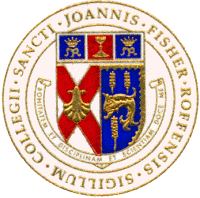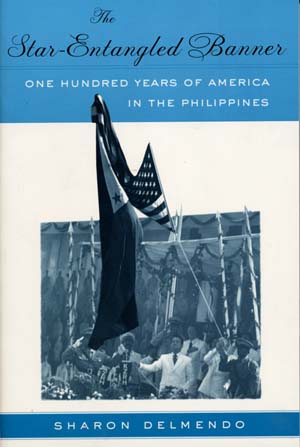
|
Department of English
St. John Fisher College 3690 East Avenue Rochester NY 14618 |
Sharon Delmendo, PhD
Professor of English Office: Basil-123 Office Phone: (585) 385 8216 |

Research:
- The Star-Entangled Banner: One Hundred Years of America in the Philippines
The Star Entangled Banner explores Philippine-American relations as emerging out of a complicated symbiotic relationship. Philippine nationalism did not emerge solely in counterdistinction to U.S. imperialism, but rather relied on the U.S. model of nationalism in multiple and vexed ways. Likewise, the U.S. both nurtured and suppressed Filipino nationalism in its attempts to define American nationalism.
In terms of the development of U.S. nationalism the fraught engagement with colonialism defined the terms of nationalist discourse during the late nineteenth century. On one hand, the ideology of Manifest Destiny posited that the United States, in order to be the United States, was forced, indeed obligated, to conquer other countries. In addition the model of America as providing tutelage in democracy, which has been central to the U.S. perception of its relationship to the Philippines, spoke powerfully to basic tenets of American nationalism. Anti-imperialists, on the other hand, also deployed nationalist ideology to argue that the forcible annexation of other countries was a betrayal of the most sacred American nationalist principles.
On the Philippine side, almost from its inception in the late nineteenth-century, Philippine nationalism has been structured around the fact of U.S. engagement. From the beginning, Philippine nationalism relied upon U.S. images and rhetoric, problematic as those were, and throughout the twentieth-century, a prominent view of Philippine nationalism has posited that it is only through strong political economic connections to the U.S. that the Philippines can achieve national autonomy, however ironically defined. Other expressions of Philippine nationalism cast the U.S. as the villain, identifying the U.S. as the source of all ills in the Philippines. In either articulation, the U.S. is central to the Philippines’ attempt to define itself as a nation. Filipino nationalism required both an American enemy and an American model in order to exist. Similarly, beginning in the early twentieth-century, the Philippines became the site where the U.S. worked out conflicting definitions of American nationalism. Thus the two countries have, for well over a century, been locked in a danse colonial which continues to this day. The Star Entangled Banner explores some of the ways in which the two nations and their nationalisms have simultaneously invoked and disavowed the costs and benefits of the Philippine-American “special relationship.”
Each of the book’s chapters show that the history of the Philippine American engagement has never been one of simple conquest, or resistance, successful or not, but one of mutual cultural and ideological entanglement. Chapter One examines José Rizal’s formulation of a Filipino nationalism at a time when "Filipino" was a term Spanish colonizers claimed, and those we now call Filipinos were designated "Indios", based on his impressions of heroic American Indians performing in Buffalo Bill's Wild West. The Indio/Indian connection was one that proved devastating in the Philippines during the Philippine-American War, when American politicians and military leaders exported the ideology of the U.S.' "Indian Wars" to the tropics. Chapter Two examines the development of and allegiance between anthropology, photography, and tourism in the 1904 St. Louis World's Fair's Philippine Reservation and Brownies in the Philippines, a popular turn-of-the century children's book. Chapter Three analyzes Back to Bataan, a World War II film directed by Edward Dmytryk and starring John Wayne as a quasi-MacArthur figure and Anthony Quinn as the putative grandson of Filipino revolutionary leader Andres Bonifacio. This chapter investigates Back to Bataan’s celebration of liberatory global Americanism through its depiction of the fruition of colonial tutelage in the Philippines. The film ostensibly promotes Philippine "freedom" but ultimately functions not to nurture Filipino independence, but to establish Philippine neo-colonial dependency in the year before the official grant of Philippine independence scheduled for July 4, 1946.
Chapter Four scrutinizes the complexities of determining the originating date of Philippine Independence, an independence which some Filipino nationalists argue still has not been fully achieved. July 4, 1996 was the 50th anniversary of the United States’ formal grant of Philippine Independence. In the weeks leading up to July 4, popular political and newspaper debates simmered over celebrating July 4 as "Philippine-American Friendship Day." The state-sponsored 50th anniversary celebration at Manila's Luneta included a reenactment of the July 4, 1946 ceremony in which the U.S. granted formal independence to the Philippines. During that ceremony, the American flag was lowered and the Philippine flag as raised to symbolize the transition in political sovereignty. During the 1996 reenactment, however, the two flags became entangled on the line, presenting an inescapably ironic moment of political symbolism. This chapter conducts an extensive analysis of both Philippine and American statements on the nature of the U.S.-Philippine relationship, not solely as regards the past, but as it bears on current aspects of the two countries’ relationship such as continuing USAID, the relationship between the American and Philippine militaries, and continuing economic factors for both countries stemming from the Philippine-American "special relationship."
Chapter Five considers F. Sionil José’s Viajero: A Filipino Novel (1993) as the articulation of an genuine Filipino nationalism, one which truly works toward a "Philippines for Filipinos." This is the project which José formulated but could not fulfill in his better-known Rosales quintet. In Viajero, José presents the successful emergence of a nationalist protagonist, significantly named Salvador dela Raza (Savior of the Race), a Filipino dislocated and exiled from the Philippines during World War II and adopted by an African-American soldier. Salvador dela Raza fulfills the promise of his name by devoting his life to the tao (people) and to the betterment of the entire nation that Sionil José developed as the definition of a true Filipino nationalist in the five Rosales novels.
The concluding chapter, "The Battleground of History," details the on-going controversy over the disposition of the so-called Balangiga Bells, two church bells taken by the U.S. military as war booty following the "Balangiga Massacre" on September 28, 1901. This chapter examines the Balangiga Bells within the larger context of the Philippine-American War in general and the Samar campaign in specific, a campaign marked by allegations of U.S. atrocities. This chapter follows the continuing negotiations over returning the bell(s) to the Philippines and surveys the ways in which perceptions about the nationalistic legitimacy of each country’s past confers legitimacy, or lack thereof, on the national present.